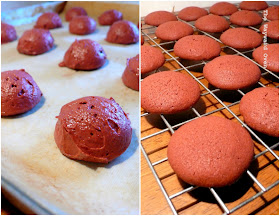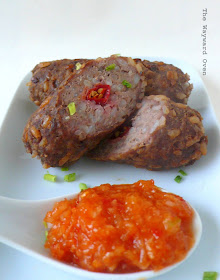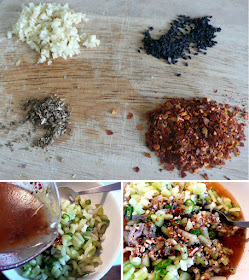| WHOOPIE PIES THAT PUT ROSES IN YOUR CHEEKS |
But this isn't the place to talk about them.
I will touch on the past though, because on a day like this, it's nice to reminisce about the good times. And a lot of those times, of course, involve food.
My mother used to make Swiss rolls a lot when I was little. A sponge with strawberry jam filling, which was pretty when sliced. We would eat it in bits, from the open end of the spiral to the final bite in the centre. (I'm sure children around the world found it amusing to eat it that way too!)
"Swiss roll" was probably the most exotic and glamorous name for a cake we had heard. Why is it called Swiss roll? Is it really from Switzerland? How do they get the jam in the middle? My parents would have fielded those questions repeatedly.
Imagine if we had ever come across something called a whoopie pie. And red velvet at that? It didn't look like any pie we would have seen. And the only cream cheese we were familiar with was that processed goo that came in glass jars.
Whoopie pies would have kept us in awe for quite a while.
Nowadays "whoopie pie" has become part of mainstream culinary vocabulary, just like macarons, cake pops, Korean tacos and molecular gastronomy. Red velvet – not new in the cake world – is simply one of the latest variations in whoopie pie-dom.
I've wanted to make whoopie pies for a while now but it wasn't until I was over at Baking Diary that Jeannie's gorgeous red velvet cookies inspired me to finally get to it. A good way to celebrate Merdeka Day (Malay for freedom or independence), I thought.
I wasn't fortunate enough to get the day off today. When you work in a newspaper, you have to put one out every day (we have four press shutdowns in a year and Merdeka Day is not one of them). But at least I'll have a nice treat to look forward to at the office.
 |
| Use an ice cream scoop for consistency in size |
I had imagined myself coming with an unusual flavour for both cake/cookie and filling, but in the end I went with red velvet. It is chocolate, after all (despite the red colouring), and that's never bad.
I used the recipe at Jeannie's blog, which comes from Joy of Baking, with just two changes. The recipe calls for buttermilk which I made by reconstituting powdered milk and then added a tablespoon of lemon juice. However, the milk didn't become as thick as real buttermilk, so I used slightly less (150ml compared to 180ml) of it.
As for the red colouring, I used food gel instead of liquid colouring. The gel comes in tiny tubs that hold, oh, I would say a tablespoon, and I used about 1½ teaspoons. I'm pretty happy with the rosy shade of red.
I formed the cookies with a small ice cream scoop to keep the size uniform, and got 44 cookies from the batter. One was a little bigger and the last one was smaller than the rest, so of course those two became the cook's treat!
When the cookies were cool, I started out sandwiching the pies one by one – holding one half, laying on the filling (also with an ice cream scoop) and placing the top on, like so:
| An ice cream scoop apportions the filling equally as well |
And then I wised up and made a whoopie pie-filling assembly line – halves laid out on a tray, filling scooped on each one, and lids on. Quick and with less handling by my clumsy self.
| Pretty rosy maids all in a row |
For two of the cookies, I separated a little frosting and mixed in a tinge of green food gel and a drop of peppermint extract. I thought I would press the sides of the filling in some chopped up green mint sweets but by that time, the frosting had softened and was spreading all over the place.
 |
| Red velvet whoopie pies with mint frosting |
To those who have the day off today, have a good break and a lovely three-day weekend. And to Malaysians,
HAPPY MERDEKA DAY!







